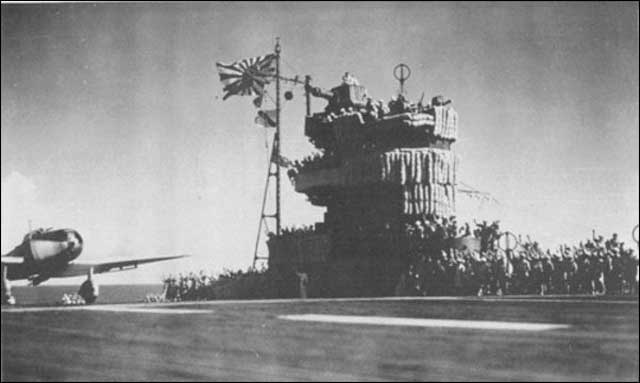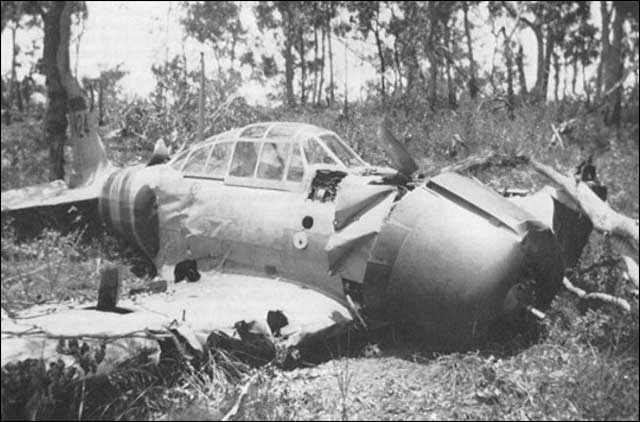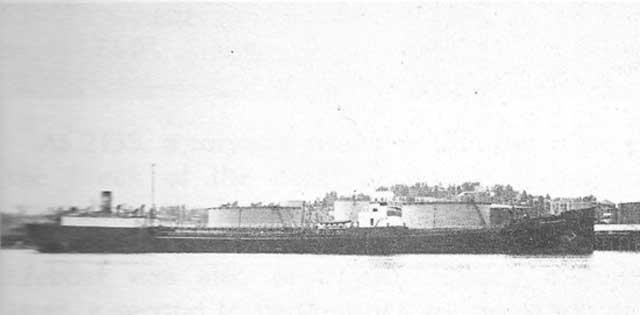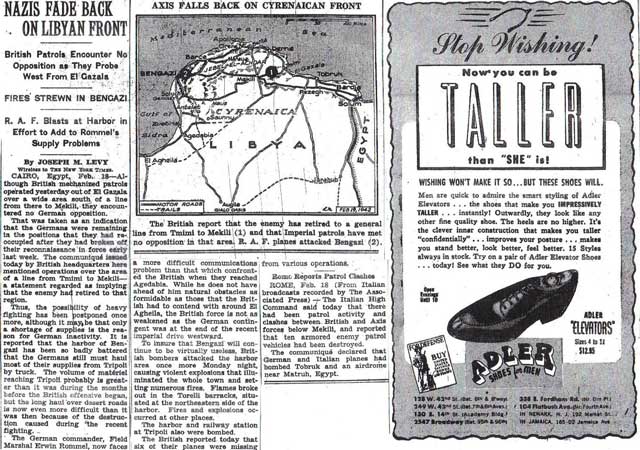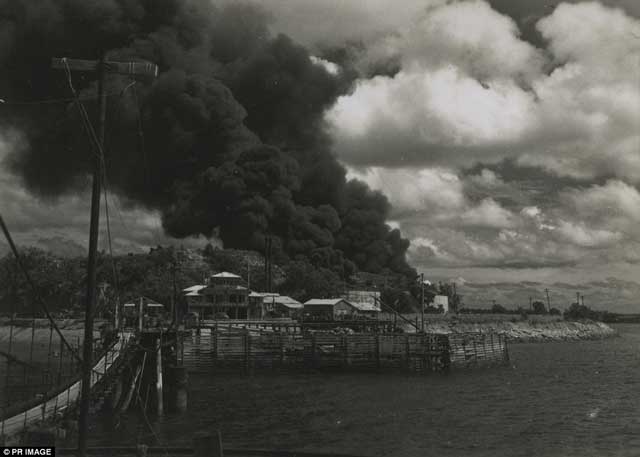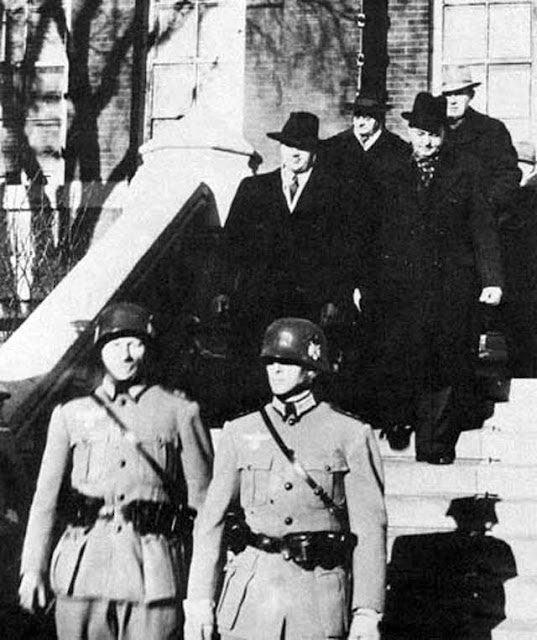Thursday 19 March 1942
 |
| A Supermarine Spitfire on board HMS Eagle, ca. 19 March 1942. The Spitfires are being taken to Malta with Force H (© IWM (A 9580)). |
The Wehrmacht advance has been difficult because there are no north-south roads in the area, requiring a difficult route through snow and trees in frigid weather. The battle is not over, and the Soviets will reopen a small gap, but this encirclement in Operation Raubtier is the first major German success in the USSR since the fall.
In Crimea, General Erich von Manstein is preparing an attack on the Soviet line in the Parpach Narrows. He wishes to recover the small amount of territory lost in the recent Soviet attacks. However, the Soviets also are building up their own forces for a renewed attack. The only question is which side attacks first. Manstein's offensive, which he has prepared hurriedly and that relies on inexperienced troops using sketchy Czech tanks, is scheduled for the morning of 20 March 1942.
 |
| "PORT MORESBY, NEW GUINEA. 1942-03-19. THICK SMOKE BILLOWS UP FROM TUAGUBU HILL AFTER A JAPANESE AIRCRAFT ATTACK AGAINST A 3.7 INCH ANTI-AIRCRAFT BATTERY." Australian War Memorial 129807. |
Toungoo, now under Japanese attack, is the original training base of the American Volunteer Group (AVG) aka the "Flying Tigers." The AVG pilots and ground crew have had to "bug out" to northern India and China. Lieutenant General William J. Slim, former General Officer Commanding 10th Indian Division in Syria, arrives in Burma to take command of Imperial troops. Slim wants to hold the current Prome-Toungoo defensive line, which is good defensive terrain due to the presence of heavy jungles.
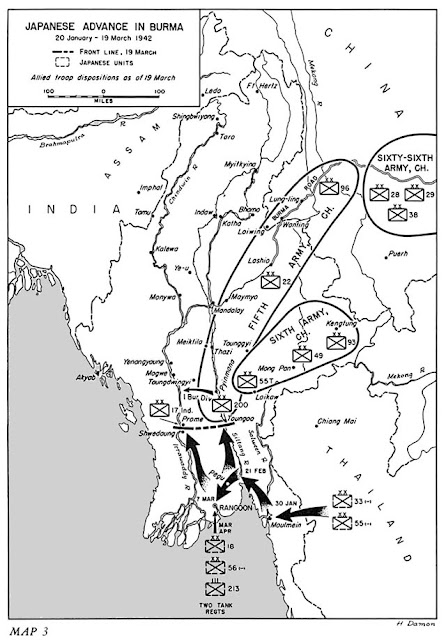 |
| The situation in Burma as of 19 March 1942 (Charles F. Romanus, Riley Sunderland). |
Seven Japanese bombers raid Darwin city, Myilly Point, and Larrakeyah in the Northern Territory of Australia. The 9th Fighter Squadron of the 49th Fighter Group, USAAF scrambles from Batchelor Field (where General MacArthur landed recently) to intercept them, but they arrive after the bombers have left.
 |
| The Mount Gambier, Australia, The Border Watch of 19 March 1942 trumpets General MacArthur's arrival on the front page. |
Japanese submarine HIJMS I-25 launches a Yokosuka E14Y1 "Glen" to reconnoiter Suva on Viti Levu Island, Fiji. As with all similar Japanese reconnaissance missions of the sort, this one goes unobserved by the Allies.
Following the path taken by General MacArthur, Philippine President Manuel Quezon and 13 members of his party use motor torpedo boat PT-41 to evacuate threatened Dumaguete, Negros Island. They sail the 240 miles to Oroquito, Mindanao Island, where the US Army still maintains an airbase.
 |
| Italian magazine Tempo features a cover story on "Surveillance aircraft at work upon enemy positions" in its issue for 19 March 1942. |
Battle of the Atlantic: The U-boat fleet has been sinking tankers almost every day recently. This has caused great concern in London and Washington and has led to fuel rationing in the United Kingdom. The situation only gets worse today as more tankers go down.
U-124 (Kptlt. Georg-Wilhelm Schulz), on its eighth patrol out of Lorient, continues a very successful patrol off the east coast of the United States when it torpedoes and sinks two U.S. tankers about 15 miles southwest of Cape Lookout:
- 5939-ton tanker Papoose (2 dead, 32 survivors)
- 7076-ton tanker W.E. Hutton (13 dead, 23 survivors)
 |
| SS Liberator, one of the ships lost on 19 March 1942. |
 |
| U.S. tanker W.E. Hutton, lost on 19 March 1942. |
- 1 JU 88 - 4 x 250kg (Ta Qali Aerodrome)
- 4 ME 109 - 4 x 250kg (Grand Harbour)
- 5 JU 88 - 20 x 250kg; 30 x 50kg (Grand Harbour)
- 6 JU 88 - 24 x 500kg (Marsaxlokk)
- 10 JU 88 - 8 x 500kg; 15 x 250kg; 36 x 50kg (Ta Qali Aerodrome)
- 3 JU 88 - 12 x 250kg; 24 x 50kg (Luqa and Safi strip)
- 6 JU 88 - 20 x 500kg (West of Luqa)
- 13 JU 88 - 44 x 250kg; 100 x 50kg (South Malta)
Royal Navy submarine Upholder (Lt.Cdr. M.D. Wanklyn) uses its deck gun to sink 22-ton Italian auxiliary minesweeper B-14 (Maria) about 20 nautical miles south of Brindisi, Italy. There is no record of casualties.
 |
| U.S. tanker Papoose, sunk on 19 March 1942. |
There are indications that the partisan movement in the region of Velikye Luki, Vitebsk, Rudnya, Velizh, is now beiing organized on a large scale. The fighting strength of the partisans hitherto active is being bolstered by individual units of regular troops.Some of the partisans are soldiers trapped during the rapid start of Operation Barbarossa. Others are Red Army troops flown in and dropped behind the German lines specifically to engage in partisan operations. The German troops sometimes see these Red Air Force planes landing in the distance to their rear and know exactly what is going on. As usual, the German response to this problem involves a massive application of force.
The Germans launch Operation Munich. This is a combined air/ground operation in the Yelnya/Dorogubuzh region against Soviet partisans. The Germans also are preparing and begin a similar anti-partisan action in the area of Hlusk District-Pariczi-Oktiabrskij to the south of Bobrujsk, in the eastern Polesie. This latter operation, more widely known, is Operation Bamberg.
In Serbia and Croatia, the Axis occupation authorities issue a draconian directive calling for the destruction of any village suspected of harboring or aiding partisans:
Removal of the population to concentration camps can also be useful. If it is not possible to apprehend or seize partisans, themselves, reprisal measures of a general nature may be in order, for example, the shooting of male inhabitants in nearby localities.The directive specifies as an example of these "reprisal measures" that 100 local inhabitants be shot for every German that is killed, with 50 to be shot for every wounded Wehrmacht soldier. This is severe even by German standards.
 |
| "USS Juneau (CL-52), March 1942. Light cruiser at New York (also known as Brooklyn) Navy Yard, New York City, New York, March 19, 1942. U.S. Bureau of Ships Photograph, now in the collections of the National Archives. (2015/02/18)." National Museum of the U.S. Navy 19-LCM-31285. |
US Military Intelligence warns that the Japanese may seize the Aleutian Islands soon. The Aleutian Islands have been a preoccupation by both sides since the 1920s, with both the US and Japan worried they will be used for bombing operations against their respective homelands. The Intelligence position is that the Japanese also would use the islands to interrupt US/Soviet communications. Soviet-flagged ships continue to pass between the United States and the USSR in the North Pacific area because Japan is not at war with the Soviet Union.
 |
| "Ratings aboard HMS WALLACE being issued with free gift cigarettes. Lieut Cdr J P Reid, RNVR, the CALO at Rosyth is handing out the gifts." 19 March 1942 (© IWM (A 7999)). |
British home secretary Herbert Morrison accuses the London paper The Daily Mirror of "reckless indifference to the national interest" for its practice of publishing stories with an antiwar slant. This has been a continuing theme of the Winston Churchill government during the war, as Churchill expects nothing but cheerleading from the British press.
US Government: Congress is busy working on the relocation of people along the west coast of the United States for defense reasons. The Select Committee Investigating National Defense Migration issues a report today recommending the imposition of a penalty of a $5,000 fine and misdemeanor conviction with the possibility of up to one-year imprisonment for persons violating restriction orders related to the military zones. This passes quickly, with little debate or discussion.
Holocaust: A new gas van, driven by two junior SS officers, Götz and Meyer, is used for the first time in Belgrade to address the "Jewish problem." These first victims of the gas van are staff and patients at the two Jewish hospitals in the city. The victims are loaded in groups of 80 and 100 and then driven through Belgrade. The vehicle exhaust is fed into the truck, killing the occupants within 15 minutes. The 800 dead in the two-day operation that concludes today are driven to Jajinci, a village at the base of mount Avala, south of the city. There, seven Serbian prisoners bury the dead in mass graves.
 |
| A Spitfire taking off from HMS Eagle, 19 to 23 March 1942 (© IWM (A 9586)). |
March 1942
March 1, 1942: Second Battle of Java Sea
March 2, 1942: Huge Allied Shipping Losses at Java
March 3, 1942: Japan Raids Western Australia
March 4, 1942: Second Raid On Hawaii
March 5, 1942: Japan Takes Batavia
March 6, 1942: Churchill Assaults Free Speech
March 7, 1942: British Defeat in Burma
March 8, 1942: Rangoon Falls to Japan
March 9, 1942: Japanese Conquest of Dutch East Indies
March 10, 1942:US Navy attacks Japanese Landings at Lae
March 11, 1942: Warren Buffett's First Stock Trade
March 12, 1942: Japan Takes Java
March 13, 1942: Soviets Attack In Crimea Again
March 14, 1942: The US Leans Toward Europe
March 15, 1942: Operation Raubtier Begins
March 16, 1942: General MacArthur Gets His Ride
March 17, 1942: MacArthur Arrives in Australia
March 18, 1942: Japan Attacks In Burma
March 19, 1942: Soviets Encircled on the Volkhov
March 20, 1942: "I Shall Return," Says MacArthur
March 21, 1942: Germans Attack Toward Demyansk
March 22, 1942: Second Battle of Sirte
March 23, 1942: Hitler's Insecurity Builds
March 24, 1942: Bataan Bombarded
March 25, 1942: Chinese Under Pressure in Burma
March 26, 1942: Win Or Die, Vows MacArthur
March 27, 1942: The Battle of Suusari
March 28, 1942: The St. Nazaire Commando Raid
March 29, 1942: The Free Republic of Nias
March 30, 1942: Japanese-Americans Off Bainbridge Island
March 31, 1942: Japanese Seize Christmas Island
2020













